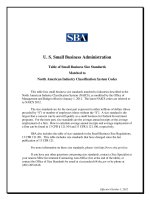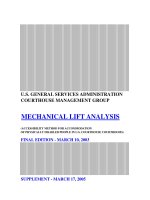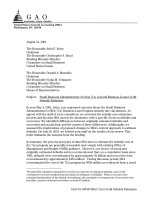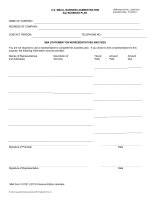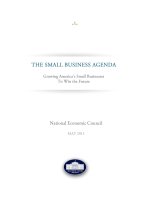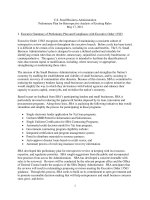U.S. Small Business Administration Preliminary Plan for Retrospective Analysis of Existing Rules doc
Bạn đang xem bản rút gọn của tài liệu. Xem và tải ngay bản đầy đủ của tài liệu tại đây (145.71 KB, 12 trang )
1
U.S. Small Business Administration
Preliminary Plan for Retrospective Analysis of Existing Rules
May 17, 2011
I. Executive Summary of Preliminary Plan and Compliance with Executive Order 13563
Executive Order 13563 recognizes the importance of maintaining a consistent culture of
retrospective review and analysis throughout the executive branch. Before a rule has been tested,
it is difficult to be certain of its consequences, including its costs and benefits. The U.S. Small
Business Administration’s plan is designed to create a defined method and schedule for
identifying certain rules that are obsolete, unnecessary, unjustified, excessively burdensome, or
counterproductive. The agency’s review process is intended to facilitate the identification of
rules that warrant repeal or modification, including, where necessary or appropriate,
strengthening or modernizing those rules.
The mission of the Small Business Administration is to maintain and strengthen the Nation’s
economy by enabling the establishment and viability of small businesses, and by assisting in
economic recovery of communities after disasters. Because of this mission, SBA is committed to
reducing the regulatory burdens facing small businesses and continues to explore initiatives that
would simplify the way in which they do business with Federal agencies and enhance their
capacity to access capital, create jobs, and revitalize the nation’s economy.
Based in part on feedback from SBA’s participating lenders and small businesses, SBA is
particularly invested in reducing the paperwork burden imposed by its loan, innovation and
procurement programs. Along those lines, SBA is analyzing the following initiatives that would
streamline and simplify the process for participating in these programs:
Single electronic lender application for 7(a) loan programs;
Uniform SBIR Portal for Information and Solicitations;
Single Uniform Certification for SBA Contracting Programs;
Automated credit decision model for 7(a) loan program;
Government contracting program eligibility website;
Integrated certification and program management system;
Portal to distribute materials to resource partners;
Auto-approve disaster loans based on credit scores; and
Automate process of receiving insurance recovery information.
SBA developed this preliminary plan for retrospective review in keeping with its resources,
expertise, and regulatory priorities. SBA sought suggestions from the public and incorporated
best practices from across the Administration. SBA has developed a concrete timetable with
rules to be reviewed. Reviews will be conducted by the relevant program office and the Office
of General Counsel under the auspices of the SBA Deputy Administrator. SBA anticipates that
the reviews will result in rulemakings proposing revisions meeting the Executive Order 13563
guidance. Through this process, SBA seeks to build on its commitment to open government and
to promote reasonable decision-making that will help entrepreneurs and small business concerns
start, grow, and thrive.
2
II. Scope of Plan
a. SBA Rulemaking Offices
The agency’s regulatory framework is structured around the program offices that oversee the
various agency programs: Office of Advocacy, Office of Capital Access, Office of Disaster
Assistance, Office of Entrepreneurial Development, Office of Government Contracting and
Business Development, Office of Hearings and Appeals, Office of International Trade, and
Office of Investment and Innovation. SBA’s regulations are codified at Title 13 Code of Federal
Regulations, Chapter I, and consist of Parts 100 through 147. SBA’s high-level agency official
responsible for retrospective review of Agency rules is Marie Johns, Deputy Administrator,
The Office of General Counsel provides support to the Deputy
Administrator.
b. Types of documents covered under this plan:
This plan covers all of SBA’s existing rules. Any review of a listed rule may also include related
guidance, information collections and other documents.
III. Public Access and Participation
a. Public Access.
On March 14, 2011, SBA published a notice in the Federal Register to solicit comments from the
public on how the Agency can develop its retrospective review plan, including suggestions for
specific rules to be reviewed and issues that should be addressed. The notice is available at
SBA received eleven comments in response to the Federal Register notice from a mix of small
business trade organizations, a small business owner, an SBA loan program participant, an
advocacy and research organization, associations of research universities, and individual
members of the general public.
Three of the commenters raised concerns with SBA’s regulations; two commented on the
guaranteed loan programs and one on the Small Business Investment Company (SBIC) program.
These commenters identified specific regulations or programs that are deemed to be burdensome
or unnecessarily complex and suggested ways in which SBA can streamline or clarify those
regulations. None of the commenters promoted repeal of any regulations but two presented ideas
for modifying certain loan terms, program eligibility criteria, and various application processes.
Two of these commenters also suggested ways in which SBA can conduct the retrospective
regulatory review.
Some commenters addressed concerns with regulations at other agencies that deal with taxation,
transportation, and the environment, particularly compliance with the clean air and clean water
requirements. The comments from individual small business owners related to tax burdens have
3
been referred to SBA’s Office of National Ombudsman (ONO). This office’s mission is to
create a fair and less burdensome regulatory enforcement environment for small business
government wide. ONO acts as a liaison between these businesses and other federal agencies to
resolve issues related to perceived excessive or unfair federal regulatory enforcement actions,
such as repetitive audits or investigations, fines, penalties, threats, retaliation, or other
enforcement actions by a federal agency.
Some commenters urged that the goals of the retrospective review should be to harmonize
regulations, eliminate unnecessary duplication, eliminate regulations that do not add value or
enhance accountability, provide targeted exemptions for certain groups, ensure regulations meet
their goals in terms of performance, rather than in terms of process, and be cost-effective for the
public.
In support of SBA’s Federal Register notice, the Senate Small Business Committee also released
a statement encouraging public response to the SBA Request for Information. This statement
can be viewed at:
/>4702-bdc5-de471f773f5d&ContentType_id=4bfd610b-f7c6-4d07-9c74-
7aab32dd9838&Group_id=0a5867cf-c34c-421f-969b-
ea2a5b192a22&MonthDisplay=3&YearDisplay=2011.
SBA’s Office of Advocacy will participate in the process to determine whether some of the
issues raised have such an impact on small entities that it would be appropriate to encourage the
applicable agencies to consider alternatives that would minimize small entity impacts. SBA will
analyze other comments to determine if there are any cross-cutting issues that require or could
benefit from inter-agency collaboration.
b. Public Participation.
SBA has taken several actions to identify and take steps to reduce regulations that are outdated or
overly burdensome to entrepreneurs. The plan will be posted on SBA’s website and comments
will continue to be invited from all sources.
1. Startup America Initiative.
As part of the White House’s Startup America initiative, senior Administration officials,
including SBA representatives, visited eight cities to meet with entrepreneurs and hear directly
from them on ideas and suggestions for reducing barriers and regulations to build a more
supportive environment for entrepreneurship and innovation. Information on the Startup
America: Reducing Barriers roundtable events can be found at www.sba.gov/content/startup-
america-reducing-barriers-roundtables.
This roundtable series is part of the Administration’s overall Startup America efforts to support
start-ups and entrepreneurs with tools and resources to grow America’s economy and win the
future. SBA is accepting ideas and proposed innovations from the public about reducing barriers
in response to the following prompt question: “What concrete ideas could reduce Federal
4
barriers for entrepreneurs trying to start and scale companies?” at
Some of the initial ideas include:
Pair bank loans with guidance from small business development centers or other third
parties;
Explore flexibility in lending criteria;
Increase participation of lenders and borrowers in underserved communities;
Simplify Federal Acquisition Regulations and other Federal procurement requirements to
make it easier for small businesses to participate;
Create new mechanisms for small businesses to find mentors and prime contractors, and
vice versa;
SBA is exploring the feasibility of these collected ideas. Using the input from the roundtables
and broader public participation, the Administration will produce a report highlighting ideas to
streamline and simplify unnecessary barriers to America’s entrepreneurs and innovators. These
ideas will be incorporated into SBA’s retrospective review process. More information on the
roundtable events is available at www.sba.gov/startupamerica. For small business owners and
entrepreneurs who are not able to attend one of the roundtables, Startup America will provide the
opportunity to submit ideas, comments and suggestions online to also be considered for inclusion
in the final report. SBA is also exploring the use of contests and prizes to solicit ideas for
reducing regulatory burden from the public. Use of contests and prizes would be carefully
tailored to achieve increased participation within the parameters of funding and authority
requirements for contests and prizes.
2. Small Business Jobs Act Tour.
In addition, SBA is in the process of conducting a multi-city tour to solicit feedback from the
public on the development of rules implementing the Small Business Jobs Act (“SBJA”). We
expect that information gathered will also inform the regulatory process review generally.
Information on the SBJA Tour can be found at www.sba.gov/jobsacttour.
IV. Current Agency Efforts Already Underway Independent of E.O. 13563
a. Summary of pre-existing agency retrospective analysis of existing rules:
SBA’s current review policy incorporates the requirements of E.O. 12866 and section 610 of the
Regulatory Flexibility Act (RFA). Under E.O. 12866, program offices are required to
periodically review their existing significant regulations to determine whether any such
regulations should be modified or eliminated. Any significant regulations selected for review are
included in SBA's Annual Regulatory Plan. SBA also identifies any legislative mandates that
require it to issue or continue to impose regulations that SBA believes are unnecessary or
outdated because of changed circumstances. The RFA requires SBA to publish and implement a
plan for reviewing existing and subsequently issued rules that have a significant economic
impact on a substantial number of small entities. The RFA 610 review helps to determine
whether such rules should be continued without change, or should be amended or rescinded, in
order to minimize the economic impact on small entities. SBA must review any such rules
5
within 10 years of their publication as a Final Rule. The RFA review involves considering the
continued need for the rule; the nature of complaints or comments received about the rule; the
complexity of the rule; the extent of duplication or conflict with other Federal, State or local
regulation; and any relevant economic or technological changes that have occurred since the last
review or development of the rule.
b. Specific rules already under consideration for retrospective analysis.
SBA has just completed a comprehensive review of the regulations for the 8(a) Business
Development/Small Disadvantaged Business program (8(a)BD) (Part 124). The final rule
reflects an extensive public and tribal participation process, including a lengthy notice and
comment period, public hearings in diverse areas of the country, and consultations with various
groups. See, 76 FR 8221 (Feb. 11, 2011). The 8(a)BD program provides small businesses with
support to help them compete for and win federal government contracts, and helps to put them in
a better position to drive economic growth and create jobs. Prior to amending the 8(a)BD
regulations, certain sections were deemed too restrictive and to unduly preclude firms from being
admitted to the business development program. The changes to these regulations will strengthen
the program and help to ensure that the benefits flow to the eligible participants. For instance,
the regulations tighten the requirements for joint ventures to ensure that non-disadvantaged firms
do not unduly benefit from the 8(a) BD program. The regulations also clarify that Subchapter S
Corporations are treated the same as C Corporations when determining economic disadvantage,
and expand this treatment to Limited Liability Companies and Partnerships. SBA’s intent is to
not penalize a firm because of the different tax structures. If the business can demonstrate that
funds reported on the individual tax return were used to pay taxes or reinvested into the firm,
SBA will not count those funds as personal income. Other benefits to small businesses as a
result of these regulations include: owners of 8(a) firms called to active military status may elect
to be suspended in order not to lose any of their 9-year term in the program; added objective
criteria to determine economic disadvantage based on personal income ($250,000 for initial
eligibility, $350,000 for continued eligibility) and total assets ($4 million for initial eligibility, $6
million continued eligibility); an immediate family member of a current or former 8(a) firm may
own an 8(a) firm where there are no or negligible connections between the two firms and the
family member can demonstrate sufficient management and technical experience to
independently operate the firm.
SBA also recently completed a comprehensive review of the regulations for its hearings and
appeals process. See 75 FR 47435 (August 6, 2010). This rule clarified and streamlined current
practices and made them more transparent and more understandable, especially for SBA’s many
small businesses that are appearing pro se.
SBA also recently designed the Women-Owned Small Business Federal Contract Program to
specifically reduce the burden on women-owned small businesses. See 75 FR 62258 (October 7,
2010). In particular, the rule identified 83 industries by four digit North American Industry
Classification System (NAICS) codes in which WOSBs are underrepresented or substantially
underrepresented; removed the requirement that each Federal agency must certify that it had
engaged in discrimination against WOSBs in order for the program to apply to that agency;
allowed WOSBs and EDWOSBs to self-certify their status as long as adequate documents were
6
provided to support the certification and posted to a document repository; allowed WOSBs or
EDWOSBs to be certified by approved third-party certifiers, including Federal agencies; and
expanded the eligibility examination process to provide new tools to review the eligibility of
WOSBs or EDWOSBs for the program. The rule also set forth the eligibility criteria for the
program, as well as the protest and appeal process for WOSB and EDWOSB status protests.
SBA is currently conducting a review of its size regulations to determine whether the existing
small business size standards in the North American Industry Classification System (NAICS)
should be retained or revised. SBA is committed to reviewing all of its small business size
standards on a rolling basis and to continue to review one-third of its size standards every 18
months.
SBA is also reviewing the regulations for the Agency's 504 Certified Development Company
(CDC) Loan Program. This review is focused on simplifying processes and reducing the
regulatory burdens on program participants, while maintaining controls to mitigate risk;
expanding program access for other nonprofit economic development entities, especially in
communities not currently served; clarifying issues that have impacted participants’ ability to
comply with program requirements; and conforming the regulations to current statutory
requirements.
Finally, prior to issuance of E.O. 13533, SBA had already begun to consider reviewing
regulations or directives for several other programs: HUBZone; Small Business Innovation
Research (SBIR); Small Business Technology Transfer (STTR); Service-Disabled Veteran-
Owned Small Business Concern (SDVOSBC); and Certificate of Competency (COC).
V. Elements of Preliminary Plan/Compliance with E.O. 13563
a. Strong, ongoing culture of retrospective analysis.
SBA already has a culture of retrospective analysis that embodies the requirements of E.O.
12866 and section 610 of the RFA. However, to further enhance the process required by E.O.
13563, SBA has included high level agency officials as part of the process from the beginning
that fully support retrospective review. SBA solicits input from those offices that are responsible
for implementing the rules. The program offices’ day-to- day involvement with the rules and
interaction with the various program participants provide invaluable insight into any issues
resulting from implementation and enforcement of the rules. SBA will also incorporate best
practices or lessons from experience with the new retrospective review process into the agency’s
standard operation procedures for regulations, SOP 70 20 3, Regulation Development and
Review Program.
b. Prioritization Factors and Processes.
Initially SBA will use length of time since last comprehensive review coupled with program
office assessment of the need for retrospective review based on their experiences implementing
the regulations and the comments or complaints from those subject to the regulations. SBA will
also consider those program regulations that have undergone multiple changes in recent years,
7
whether necessitated by statutory mandates or changes in policy to ensure that they reflect the
current economic environment and are harmonized with related regulations. In choosing rules
for review, SBA will consider achievement of the following objectives: (1) promotion of
economic growth, innovation, competitiveness, and job creation; (2) elimination of outdated
regulations; (3) lessening the burdens imposed on those directly or indirectly affected by our
regulations, particularly small entities; (4) increasing transparency and delivery of benefits to the
public by our regulations, and improving the cost-benefit balance of our regulations; (5)
elimination of duplicative or overlapping regulations; (6) reduction of paperwork by eliminating
duplication, lessening frequency, allowing electronic submission, standardizing forms,
exempting small entities, or other means; (7) elimination of complexity and confusion arising
from conflicts and inconsistencies in SBA’s regulations; (8) simplification and clarification of
language in regulations; (9) revision of regulations to address changes in technology, economic
conditions, or other factors; (10) determining if matters in an existing regulation could be better
handled fully by trade organizations or participants without Federal regulations; (11) reduction of
burdens by incorporating industry consensus standards into regulations; (12) reconsideration of
regulations that were based on scientific or other information that has been discredited or
superseded; and (13) expansion of regulations that are insufficient to address their intended
objectives or obtain additional benefits.
c. Initial list of candidates for review over the next two years.
SBA has identified for its initial candidate list of rules for retrospective review the following:
Certified Development Company Loan Program (Part 120, Subpart H); Small Business Size
Standards (Part 120, sectors 22, 56, 51 and 53); Small Business Innovation Research Program
(SBIR Policy Directive); and the Small Business Technology Transfer Program (STTR Policy
Directive). SBA will also review information collections for each of these programs in light of
the goals of the initiative.
As part of this retrospective review, SBA is also studying the following burden reduction
initiatives:
Single electronic lender application for 7(a) loan programs.
There is potential for process improvement by adopting a single e-application for all SBA 7a
guaranteed loans. This would reduce the paperwork burden on lenders (which in turn impacts
small business borrowers), and will result in greater lender participation, particularly small
community banks, credit unions, and rural lenders. These lenders usually support small
businesses who seek relatively small amounts of capital to grow and succeed; hence, additional
small, community lender-partners will potentially lead to increasing the amount of small dollar
loans flowing to small businesses. This e-application could add value by reducing the screen out
rate currently experienced during the loan application process and could improve the timeliness
of delivering loan approvals and hence delivery of loan proceeds to small businesses.
Uniform SBIR Portal for Information and Solicitations.
8
For the Small Business Innovation Research program, there is no one form or database for
applying for the program and submitting proposals. Often, there are multiple systems for a
single submission – e.g., eRA Commons (Electronic Research Administration NIH website) and
Grants.gov - in addition to the lack of uniformity across the participating eleven agencies in the
program. The goal of the project would be to create a common, simple application form that
ports over application data into the agencies’ application systems on an as-needed basis. This
would not replace other application systems, but it would be a common form that ports data over
more simply to multiple application systems. In addition to the technology solution, the business
process of narrowing and simplifying into a common base of information can be open-sourced to
multiple agencies, as they may navigate the same challenges of common applicants for different
programs.
Single Uniform Certification for SBA Contracting Programs.
SBA will analyze the regulatory changes required and implications of developing and
implementing a single certification process for common information collected across its small
business contracting programs, such as the 8(a) Business Development, HUBZone, Women-
Owned Small Business, Service-Disabled Veteran-Owned Small Business, and other Small
Business Programs.
Automated credit decision model for 7(a) loan program.
For loans of less than $250k, SBA could develop an optional credit scoring methodology to be
used by SBA lender partners in their underwriting process which could result in lowering the
lenders’ cost of delivering capital to borrowers and would likely expand their interest in making
low dollar loans. This initiative may also attract additional lenders (e.g., small community
banks, credit unions, and rural lenders) to become SBA partners and increase credit availability
for small businesses.
Government contracting program eligibility website.
SBA will analyze the feasibility of building a one-stop website for small businesses to input
basic information about their business (e.g., number of employees, revenues, ownership (e.g.,
women-owned, service-disabled veteran-owned, minority owned)) to determine contracting and
loan programs they may be eligible for, as well as help identify local district offices and resource
partners in their area. This would make it easier for the public to access and participate in
Federal small business programs.
Integrated certification and program management system.
SBA will review development of a system that will allow the certification and program
management (e.g., reviews, protests) processes to be done electronically for the 8(a) and
HUBZone programs. The system is also planned to be developed to allow for future additions
for other programs such as the Women-Owned Small Business Program and the Service-
Disabled Veteran-Owned Small Business program. This system would enable easier access to
9
the small business programs and reduce the amount of paperwork submitted to SBA by
applicants.
Portal to distribute materials to resource partners.
SBA’s web development team will review creation of a central portal to hold materials (e.g.,
training materials, fact sheets, FAQs, talking points) across all program offices that the field and
resource partners could search through to find the latest information for each program.
Auto-approve disaster loans based on credit scores.
Private industry approves a substantial number of loans through credit scoring to reduce the cost
of underwriting. The portfolio analysis that is being currently completed indicates that the
performance of loans to borrowers with a > 725 FICO score have limited risk. Changing this
process would allow SBA more flexibility to design a loan approval that is in line with current
private sector practices and reduce the processing cost for lower dollar disaster loans.
Automate process of receiving insurance recovery information.
Under the disaster loan program, loan eligibility is based on the uncompensated disaster loss.
Being able to automate the insurance recovery information would enhance our ability to ensure
that insurance proceeds are addressed and no duplication of benefits occurs as a result of
insurance recovery after loan approval. This would reduce the possibility that disaster victims
will be asked to repay erroneously disbursed Federal disaster benefits.
e. Independence of Retrospective Review Team.
SBA’s current rulemaking process involves both program offices, support offices, and the Office
of General Counsel, with the General Counsel designated as the agency’s Regulatory Policy
Officer. Since any meaningful review must necessarily involve the program offices that
implement the regulations, and given the size and resources available to the Agency, it might not
be feasible to establish a truly independent retrospective review process where the offices that
wrote the rules and implement them are not the same offices conducting the review. However,
SBA believes that the structure of having responsible officials in a non-program office will
provide sufficient independence. In addition, the head of the retrospective review process is the
SBA Deputy Administrator. The Deputy Administrator is the second highest official within the
Agency, as well as the official responsible for the Chief Operating Officer’s duties. The Deputy
Administrator position is ideally suited to provide necessary oversight of the retrospective review
and analysis process.
f. Actions to strengthen internal review expertise.
SBA’s Office of General Counsel will provide training to the team of employees selected to
conduct the retrospective reviews. OGC provides a comprehensive document summarizing all of
the requirements (and supporting guidance documents) for the rulemaking process. SBA is also
providing guidance and training on drafting documents in plain language. SBA will also
10
consider best practices developed internally during the process, as well as lessons learned from
other agencies, in order to develop and improve methods to strengthen internal review expertise.
After observing the process for one year, SBA will reassess the process to consider whether
additional staff or other resources or expertise would enhance the process.
g. SBA plan for retrospective analysis.
The timetable is structured around the initial candidate list of rules beginning in FY 2011 and
will be expanded to other program areas over the next 5 years.
FY 2011 through FY 2013
PROGRAM
CFR PART
REVIEW TIMEFRAME
Certified Development Company Loan
Part 120; Subpart H
FY2011-FY2012
Small Business Size Standards
Sector 22: Utilities
Sector 56: Administrative Support &
Waste Management
Sector 51: Information Industries
Sector 53: Real Estate & Rental &
Leasing
Part 121
FY2011-FY2013
SBIR (Small Business Innovation
Research)
Policy Directive
FY 2012
STTR (Small Business Technology
Transfer)
Policy Directive
FY 2012
SBIC (Small Business Investment
Company)
Part 107
FY2012-FY2013
SGB (Surety Bond Guarantee)
Part 115
FY2012-FY2013
COC (Certificate of Competency)
Part 125
FY2013-FY2014
SDVOSB (Service-Disabled Veteran-
Owned Small Business Concerns)
Part 125
FY2013-FY2014
HUBZone
Part 126
FY2013-FY2014
Small Business Size Standards
Other Sectors to be determined
Part 121
FY2013-FY2014
Analyze Single Electronic Application for
7(a) Loans
Part 120
FY2012
Analyze Automated Credit Decision Model
for 7(a) Loan Program
Part 120
FY2012
Analyze Uniform SBIR Portal For
Information and Solicitations
SBIR Policy
Directive
FY2012
Analyze Single Uniform Certification for
SBA Contracting Programs
Parts 121, 124, 125,
126
FY2012
Analyze Government Contracting Program
Eligibility Website
Parts 121, 124, 125,
126
FY2012
Analyze Integrated Certification and
Program Management System
Parts 121, 124, 125,
126
FY2012
11
Develop Portal to Distribute Materials to
Resource Partners
Parts 121, 124, 125,
126
FY2012
Implement Auto-approve Disaster Loans
Based on Credit Scores
Part 123
FY2012
Automate Process of Receiving Insurance
Recovery Information
Part 123
FY2012
h. Analytical Decisions.
The team of reviewing employees will analyze the comments and make recommendations to the
heads of those programs impacted by the comments. The senior official for this retrospective
review will provide final approval for the disposition of the comments. SBA anticipates that the
reviews will often lead to regulatory amendments.
i. SBA plans for revising rules.
First, a team is selected to conduct the retrospective review, based upon the skills and expertise
that the team will need to thoroughly review rules retrospectively. Generally, the team will
consist of program office, information technology, communication, legal, financial, and policy
experts. Those teams will then regularly meet to go over the authority for the program, the
current regulations and guidance, the forms and information collections currently used in the
program, and other relevant factors. During the process, SBA will seek suggestions from
stakeholders, participants, and other members of the public. We envision the process will be
similar to the process currently used to draft regulations within the Agency. Once the initial
round of reviews is completed, periodic reviews will be conducted at regular intervals or as
necessitated by comments or suggestions from the public.
j. Coordination with other federal agencies.
SBA is a member of various interagency councils, including the FAR Council, National
Economic Council, and the Administrative Conference of the United States (ACUS). SBA will
leverage its access to these groups to facilitate communications on cross-cutting rules.
VI. Components of Retrospective Cost-Benefit Analysis
a. Evaluation Metrics.
There are no overriding metrics of general applicability to all SBA rules; therefore each program
will be assessed to determine which methodology or approach will yield the most value.
b. Data.
Primarily, SBA will use available program data generated through current information
collections. In addition, SBA will consider data generated or developed through various small
business research sources, including data generated by research funded by SBA’s Office of
12
Advocacy. SBA will also reach out to resource partners, participants, trade organizations, and
similar groups for relevant data.
VII. Publishing the Agency’s Plan Online
SBA will publish its retrospective review plan and available data on its Open Government
website. The technical staff personnel are Kirk McElwain, Richard Custer, and Stephen Morris,
Office of Communications and Public Liaison. SBA will follow the publication guidance in
OMB Memorandum #M-11-19, Retrospective Analysis of Existing Significant Regulations
(April 25, 2011).
VIII. Results
SBA welcomes the retrospective review process as part of building a culture of creating current,
participant-friendly, cost effective, low burden, simple rules. SBA follows Open Government
principles of transparency, participation, and collaboration. SBA will publish its Final
Retrospective Review Plan for public information and for comment on its Open Government
website. SBA considers the Plan to be a living document that will be modified to keep it current
and effective to meet the goals of the initiative. In this effort, SBA will also continue to reach
out to its resource partners, participants, small businesses, entrepreneurs, contractors, grantees,
lenders, borrowers, and other members of the public to improve SBA retrospective reviews and
the retrospective review process. Since many SBA programs, especially SBA’s procurement
assistance programs, affect other Federal agencies, SBA will also continue to reach out to other
Agencies during each individual retrospective review. SBA contemplates that this will result in
all of its rules being periodically retrospectively reviewed on a rolling basis creating rules that
are more cost effective and less burdensome to participants in the Agency’s programs while
continuing to promote economic growth, innovation, and job creation.


